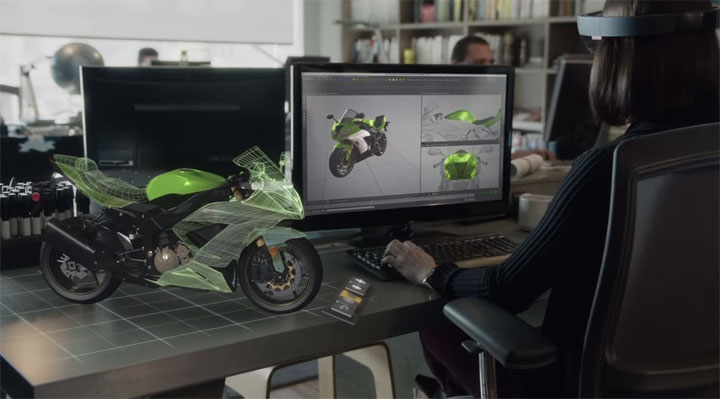TORONTO – Microsoft revealed more details of its newest operating system Windows 10 on Wednesday, in a bid to reignite consumer interest in its software. But the company’s newest innovation, also revealed at the event, is stealing the spotlight.

Meet HoloLens: An augmented reality headset that allows wearers to interact with and see 3D digital holograms in their own environment.
Like something out of a sci-fi movie, Microsoft’s promotional video shows users playing with their desktop icons and checking their calendar in the kitchen, a digital “to do” list hanging on the fridge. In another example, users are seen building a Minecraft world in their living room.
“That was science fiction, now we’re bringing it into science fact,” the video promises.
How does it work?
So, how is it that you can see 3D holograms that aren’t really there? Since holograms are made of light, HoloLens tricks the brain into thinking light is matter by producing millions of light particles inside a light engine.
The light then enters the device’s lenses and bounces around between layers of blue, red and green before getting to the user’s eye.
- Canadian man dies during Texas Ironman event. His widow wants answers as to why
- Several baby products have been recalled by Health Canada. Here’s the list
- Is home ownership only for the rich now? 80% say yes in new poll
- Invasive strep: ‘Don’t wait’ to seek care, N.S. woman warns on long road to recovery
A “Holographic Processing Unit” (HPU) and a series of sensors allow the device to run without any wires or direct connections to the user’s computer and processes graphics in real time.
To make it even more real, HoloLens even features spatial sound so users can “hear” holograms.
How is it different from other virtual reality devices?
HoloLens is garnering a lot of attention because it offers a new take on virtual reality – one that the tech community has been waiting for.
Other virtual reality headsets like Facebook-owned Oculus Rift and Sony’s Project Morpheus offer users a closed-off virtual reality experience that exists in a virtual world. The wearer can move around and manipulate the graphics within the world using gestures, but they don’t feel like they are in their own environment.
READ MORE: This is Project Morpheus; Sony’s virtual reality headset for PS4
But this new technology projects those graphics into the user’s real world.
“While immersed in a virtual world, users are best advised to stay seated or keep still to avoid collisions with physical objects they cannot see in the real world,” reads Microsoft’s website.
“Holographic experiences on Windows 10 are about delivering a mixed reality that lets you enjoy your digital life while staying more connected to the world around you.”
Is there consumer interest in these devices?
HoloLens, like many other virtual reality products, is still a concept device – making it hard to gauge consumer interest on these types of products.
But Microsoft’s unveiling comes just days after Google halted sales of its Internet-connected glasses.
READ MORE: Google to stop selling Google Glass
Google Glass, first launched in 2012, enjoyed massive interest but failed to become a consumer hit. Originally, Glass was only available to developers, but Google opened up sales to the public in April 2014.
Despite brining on popular eyewear designers to make the device more fashionable and marketable, Google said it would abandon its current design and pull the device from the market.


Comments